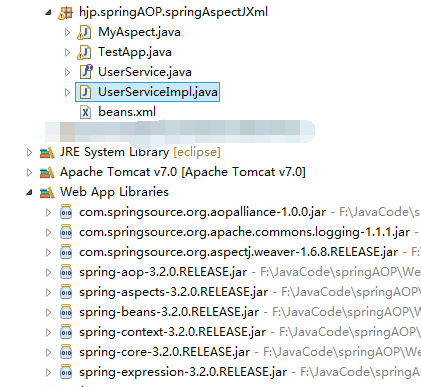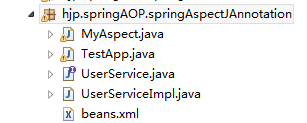AspectJ AOP学习基础
一、切入点表达式
1、execution:匹配方法的执行
格式:execution(修饰符 返回值类型 包.类.方法(参数) throw 异常)
1.1修饰符,表示方法的修饰符,一般省略。
1.2返回类型 String表示返回String;void表示没有返回值;*表示返回任意类型,包括无返回值。
1.3包
hjp.spring.service 表示指定的包
hjp.spring.*.service 表示spring下子模块包含service的包
hjp.spring.service.. 表示service目录及其子目录
综合:hjp.spring.*.service..
1.4类 UserService表示指定的类;*Service表示以Service结尾;Test*表示以Test开头;*表示任意类名。
1.5方法(与类相似)
addUser表示指定方法;add*表示以add开头;*Do表示以Do结尾;*表示任意。
1.6参数 ()表示没有参数;(int)表示一个int类型参数;(int,int)表示两个int类型参数(如果是java.lang包下的可以省略,其他类型必须写完全限定类名);(..)表示
任意,包括无参。
1.7throws 异常,一般省略。
综合:execution(* hjp.spring.*.service..*.*(..))
2、within:匹配包或子包中的方法,如:within(hjp.spring.service..*)
3、this:匹配实现接口的代理对象中的方法,如:this(hjp.spring.dao.UserDao)
4、target:匹配实现接口的目标对象中的方法,如:target(hjp.spring.daoImpl.UserDao)
5、args:匹配参数格式符合标准的方法,如args(int,int)
6、bean:匹配指定的bean,如:bean("userServiceId")
二、AspectJ规定的通知类型
1、before:前置通知(应用:各种校验),在方法执行前执行,如果通知抛出异常,阻止方法运行。
2、afterReturning:后置通知(应用:常规数据处理),方法正常返回后执行,如果方法中抛出异常,通知无法执行;在方法执行后执行,所以才可以获得方法的返回值。
3、around:环绕通知(应用:可以做任何事),方法执行前后分别执行,可以阻止方法的执行。
4、afterThrowing:抛出异常通知(应用:包装异常信息),方法抛出异常后执行,如果方法没有抛出异常,无法执行。
5、after:最终通知(应用:清理现场),方法执行完毕后执行,无论方法是否有异常出现。
环绕通知类似代码块:
try{
//前置通知(before)
//手动执行目标方法
//后置通知(after),可获得返回值
}catch{
//抛出异常通知(afterThrowing),可获得具体异常信息
}finally{
//最终(finally)
}
环绕通知类似代码块
三、基于XML配置的代码示例
1、代码结构:

2、aspectj aop不是针对接口的,所有有没有接口不影响AOP实现,下面是UserService接口和UserServiceImpl实现类(目标类)代码
package hjp.springAOP.springAspectJXml;
public interface UserService {
void addUser();
void updateUser();
}
UserService
package hjp.springAOP.springAspectJXml;
public class UserServiceImpl implements UserService {
@Override
public void addUser() {
// TODO Auto-generated method stub
System.out.println("aspectj xml add user");
}
@Override
public void updateUser() {
// TODO Auto-generated method stub
//int i=9/0;
System.out.println("aspectj xml update user");
}
}
UserServiceImpl
3、切面类MyAspect代码
package hjp.springAOP.springAspectJXml; import org.aspectj.lang.JoinPoint;
import org.aspectj.lang.ProceedingJoinPoint; public class MyAspect {
public void myBefore(JoinPoint joinPoint) {
System.out.println("前置通知:" + joinPoint.getSignature().getName());
} public void myAfterReturning(JoinPoint joinPoint, Object ret) {
System.out.println("后置通知:方法名," + joinPoint.getSignature().getName() + ";返回值," + ret);
} public Object myAround(ProceedingJoinPoint proceedingJoinPoint) throws Throwable {
System.out.println("环绕通知前");
// 手动执行目标方法
Object object = proceedingJoinPoint.proceed();
System.out.println("环绕通知后");
return object;
} public void myAfterThrowing(JoinPoint joinPoint, Throwable e) {
System.out.println("目标类方法" + joinPoint.getSignature().getName() + "抛出异常:" + e.getMessage());
} public void myAfter(JoinPoint joinPoint) {
System.out.println("最终执行通知:方法:" + joinPoint.getSignature().getName());
}
}
MyAspect
4、beans.xml配置文件,记得添加aop命名空间和引用地址
<?xml version="1.0" encoding="UTF-8"?>
<beans xmlns="http://www.springframework.org/schema/beans"
xmlns:xsi="http://www.w3.org/2001/XMLSchema-instance" xmlns:aop="http://www.springframework.org/schema/aop"
xsi:schemaLocation="http://www.springframework.org/schema/beans
http://www.springframework.org/schema/beans/spring-beans.xsd
http://www.springframework.org/schema/aop
http://www.springframework.org/schema/aop/spring-aop.xsd">
<!-- 1、创建目标类 -->
<bean id="userServiceId" class="hjp.springAOP.springAspectJXml.UserServiceImpl"></bean>
<!-- 2、创建切面类 (通知) -->
<bean id="myAspectId" class="hjp.springAOP.springAspectJXml.MyAspect"></bean>
<!-- aop编程
如果强制使用CGLIB,则设置aop:config 属性proxy-target-class="true"
-->
<aop:config>
<!-- aspectj 编程
ref指向切面类 -->
<aop:aspect ref="myAspectId">
<!-- 声明切入点,确定目标类上哪些方法需被增强 -->
<aop:pointcut expression="execution(* hjp.springAOP.springAspectJXml.*.*(..))" id="myPointCut" />
<!-- 声明通知方式 -->
<!-- 1、前置通知
method切面类中具体方法名
pointcut-ref指向切入点(使用pointcut,也可以在通知里配置自己的切入点表达式)
<aop:before method="myBefore" pointcut-ref="myPointCut"/>
-->
<!-- 2、后置通知,可获取到返回值
returning用于设置通知的第二个参数名称,类型为Object(注意:此处参数名称要与切面类后置通知方法第二个参数名称一致)
<aop:after-returning method="myAfterReturning" pointcut-ref="myPointCut" returning="ret"/>
-->
<!-- 3、环绕通知
<aop:around method="myAround" pointcut-ref="myPointCut"/>
-->
<!-- 4、抛出异常通知(测试此通知时,将目标类中updateUser方法中int i=9/0;代码注释去掉)
目标方法在抛出异常时执行,如果没有则不执行
throwing设置抛出异常通知的第二个参数,参数名称和此处设置的e一致,类型Throwable
<aop:after-throwing method="myAfterThrowing" pointcut-ref="myPointCut" throwing="e"/>
-->
<!-- 5、最终通知,即任何情况下都会执行 -->
<aop:after method="myAfter" pointcut-ref="myPointCut"/>
</aop:aspect>
</aop:config>
</beans>
beans.xml
5、测试类
package hjp.springAOP.springAspectJXml; import org.junit.Test;
import org.springframework.context.ApplicationContext;
import org.springframework.context.support.ClassPathXmlApplicationContext; public class TestApp {
@Test
public void demo1() {
String xmlPath="hjp/springAOP/springAspectJXml/beans.xml";
ApplicationContext applicationContext=new ClassPathXmlApplicationContext(xmlPath);
UserService userService = (UserService)applicationContext.getBean("userServiceId");
userService.addUser();
userService.updateUser();
}
}
测试类
四、基于注解的代码示例
1、代码结构和上面差不多

2、目标类的接口代码不变,目标类加注解后代码:
package hjp.springAOP.springAspectJAnnotation;
import org.springframework.stereotype.Service;
@Service("userServiceId")//<bean id="userServiceId" class="hjp.springAOP.springAspectJAnnotation.UserServiceImpl"></bean>
public class UserServiceImpl implements UserService {
@Override
public void addUser() {
// TODO Auto-generated method stub
System.out.println("aspectj xml add user");
}
@Override
public void updateUser() {
// TODO Auto-generated method stub
//int i=9/0;
System.out.println("aspectj xml update user");
}
}
目标类
3、切面类加注解后代码(注意:代码里面使用了引用公共切入点表达式的方法):
package hjp.springAOP.springAspectJAnnotation; import org.aspectj.lang.JoinPoint;
import org.aspectj.lang.ProceedingJoinPoint;
import org.aspectj.lang.annotation.After;
import org.aspectj.lang.annotation.AfterReturning;
import org.aspectj.lang.annotation.AfterThrowing;
import org.aspectj.lang.annotation.Around;
import org.aspectj.lang.annotation.Aspect;
import org.aspectj.lang.annotation.Before;
import org.aspectj.lang.annotation.Pointcut;
import org.springframework.stereotype.Component; @Component//<bean id="myAspectId" class="hjp.springAOP.springAspectJAnnotation.MyAspect"></bean>
@Aspect//<aop:aspect ref="myAspectId">
public class MyAspect {
//@Before("execution(* hjp.springAOP.springAspectJAnnotation.*.*(..))")//<aop:before method="myBefore" pointcut="myPointCut"/>
public void myBefore(JoinPoint joinPoint) {
System.out.println("前置通知:" + joinPoint.getSignature().getName());
}
//@AfterReturning(value="execution(* hjp.springAOP.springAspectJAnnotation.*.*(..))",returning="ret")
public void myAfterReturning(JoinPoint joinPoint, Object ret) {
System.out.println("后置通知:方法名," + joinPoint.getSignature().getName() + ";返回值," + ret);
}
//编写共有的切入点表达式
@Pointcut("execution(* hjp.springAOP.springAspectJAnnotation.*.*(..))")
private void myPointCut(){}
//@Around("myPointCut()")//注意加括号
public Object myAround(ProceedingJoinPoint proceedingJoinPoint) throws Throwable {
System.out.println("环绕通知前");
// 手动执行目标方法
Object object = proceedingJoinPoint.proceed();
System.out.println("环绕通知后");
return object;
}
//@AfterThrowing(value="myPointCut()",throwing="e")
public void myAfterThrowing(JoinPoint joinPoint, Throwable e) {
System.out.println("目标类方法" + joinPoint.getSignature().getName() + "抛出异常:" + e.getMessage());
}
@After("myPointCut()")
public void myAfter(JoinPoint joinPoint) {
System.out.println("最终执行通知:方法:" + joinPoint.getSignature().getName());
}
}
切面类
4、beans.xml配置文件,注意新加context和AOP命名空间及引用地址
<?xml version="1.0" encoding="UTF-8"?>
<beans xmlns="http://www.springframework.org/schema/beans"
xmlns:xsi="http://www.w3.org/2001/XMLSchema-instance" xmlns:aop="http://www.springframework.org/schema/aop"
xmlns:context="http://www.springframework.org/schema/context"
xsi:schemaLocation="http://www.springframework.org/schema/beans
http://www.springframework.org/schema/beans/spring-beans.xsd
http://www.springframework.org/schema/aop
http://www.springframework.org/schema/aop/spring-aop.xsd
http://www.springframework.org/schema/context
http://www.springframework.org/schema/context/spring-context.xsd">
<!-- spring注解扫描 -->
<context:component-scan base-package="hjp.springAOP.springAspectJAnnotation"></context:component-scan>
<!-- 使AOP注解生效 -->
<aop:aspectj-autoproxy></aop:aspectj-autoproxy>
</beans>
5、测试类
package hjp.springAOP.springAspectJAnnotation; import org.junit.Test;
import org.springframework.context.ApplicationContext;
import org.springframework.context.support.ClassPathXmlApplicationContext; public class TestApp {
@Test
public void demo1() {
String xmlPath="hjp/springAOP/springAspectJAnnotation/beans.xml";
ApplicationContext applicationContext=new ClassPathXmlApplicationContext(xmlPath);
UserService userService = (UserService)applicationContext.getBean("userServiceId");
userService.addUser();
userService.updateUser();
}
}
测试类
3、
AspectJ AOP学习基础的更多相关文章
- Spring AOP 学习例子
http://outofmemory.cn/code-snippet/3762/Spring-AOP-learn-example 工作忙,时间紧,不过事情再多,学习是必须的.记得以前的部门老大 ...
- AOP技术基础
1.引言 2.AOP技术基础 3.Java平台AOP技术研究 4..Net平台AOP技术研究 2.1 AOP技术起源 AOP技术的诞生并不算晚,早在1990年开始,来自Xerox Palo Alto ...
- AOP技术基础(转)
1.引言 2.AOP技术基础 3.Java平台AOP技术研究 4..Net平台AOP技术研究 2.1 AOP技术起源 AOP技术的诞生并不算晚,早在1990年开始,来自Xerox Palo Alto ...
- springBoot AOP学习(一)
AOP学习(一) 1.简介 AOp:面向切面编程,相对于OOP面向对象编程. Spring的AOP的存在目的是为了解耦.AOP可以让一切类共享相同的行为.在OOP中只能通过继承类或者实现接口,使代码的 ...
- Spring AOP学习笔记
Spring提供了一站式解决方案: 1) Spring Core spring的核心功能: IOC容器, 解决对象创建及依赖关系 2) Spring Web ...
- spring 学习(三):aop 学习
spring 学习(三):aop 学习 aop 概念 1 aop:面向切面(方面)编程,扩展功能不修改源代码实现 2 AOP采取横向抽取机制,取代了传统纵向继承体系重复性代码 3 aop底层使用动态代 ...
- Spring入门IOC和AOP学习笔记
Spring入门IOC和AOP学习笔记 概述 Spring框架的核心有两个: Spring容器作为超级大工厂,负责管理.创建所有的Java对象,这些Java对象被称为Bean. Spring容器管理容 ...
- Spring IOC 和Aspectj AOP
1.Aspectj AOP 是一套独立的AOP 解决方案,不仅限于java应用,不依赖其他方案,属于编译时增强,有自己单独的编译器.Spring AOP 是基于Spring 容器的的AOP解决方式,属 ...
- 现代3D图形编程学习-基础简介(2) (译)
本书系列 现代3D图形编程学习 基础简介(2) 图形和渲染 接下去的内容对渲染的过程进行粗略介绍.遇到的部分内容不是很明白也没有关系,在接下去的章节中,会被具体阐述. 你在电脑屏幕上看到的任何东西,包 ...
随机推荐
- 诺顿ghost备份恢复系统或分区
一 诺顿ghost简介 1,可以克隆分区 也可以克隆磁盘 2,克隆成img或磁盘内容对刻 3,磁盘分区--img---磁盘分区 磁盘---磁盘 二 操作步骤 对刻好的系统 整体思路: 1,A是模板 ...
- Contains Duplicate II
Given an array of integers and an integer k, find out whether there there are two distinct indices i ...
- ASP.NET中进行消息处理(MSMQ) 二
在我上一篇文章<ASP.NET中进行消息处理(MSMQ)一>里对MSMQ做了个通俗的介绍,最后以发送普通文本消息和复杂的对象消息为例介绍了消息队列的使用. 本文在此基础上继续介绍MSMQ的 ...
- Android调用基于.net的WebService
在实际开发项目中,有时候会为Android开发团队提供一些接口,一般是以asmx文件的方式来承载.而公布出去的数据一般上都是标准的json数据.但是在实际过程中,发现Android团队那边并不是通过将 ...
- JS案例之5——移动端触屏滑动
移动端触屏滑动的效果其实就是图片轮播,在PC的页面上很好实现,绑定click和mouseover等事件来完成.但是在移动设备上,要实现这种轮播的效果,就需要用到核心的touch事件.处理touch事件 ...
- [CareerCup] 6.3 Water Jug 水罐问题
6.3 You have a five-quart jug, a three-quart jug, and an unlimited supply of water (but no measuring ...
- IIS7 IIS7.5 配置备份
IIS 7 提供了一个新的命令行工具 Appcmd.exe,可以使用该工具来配置和查询 Web 服务器上的对象,并以文本或 XML 格式返回输出. IIS 备份还原命令如下: 开始-运行-CMD 进入 ...
- grootJs的vm结构
按看这段代码生成的vm groot.view("myview", function (vm, ve) { vm.say = "hello word!"; }) ...
- WCF入门 (14)
前言 上周去面试,跪了,这一年没什么长进,还是挺惭愧的. 得到的评语是:想的太多,做的太少. 做了一份面试题,最后一题是数据库的,写个查询.要查出Score有两次及两次以上超过79的Name和他的最高 ...
- setter方法的内存错误
- (void)setList:(ClassicList *)list { self.list = list; _titleLabel.text = list.activityName; _addre ...
